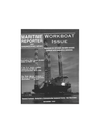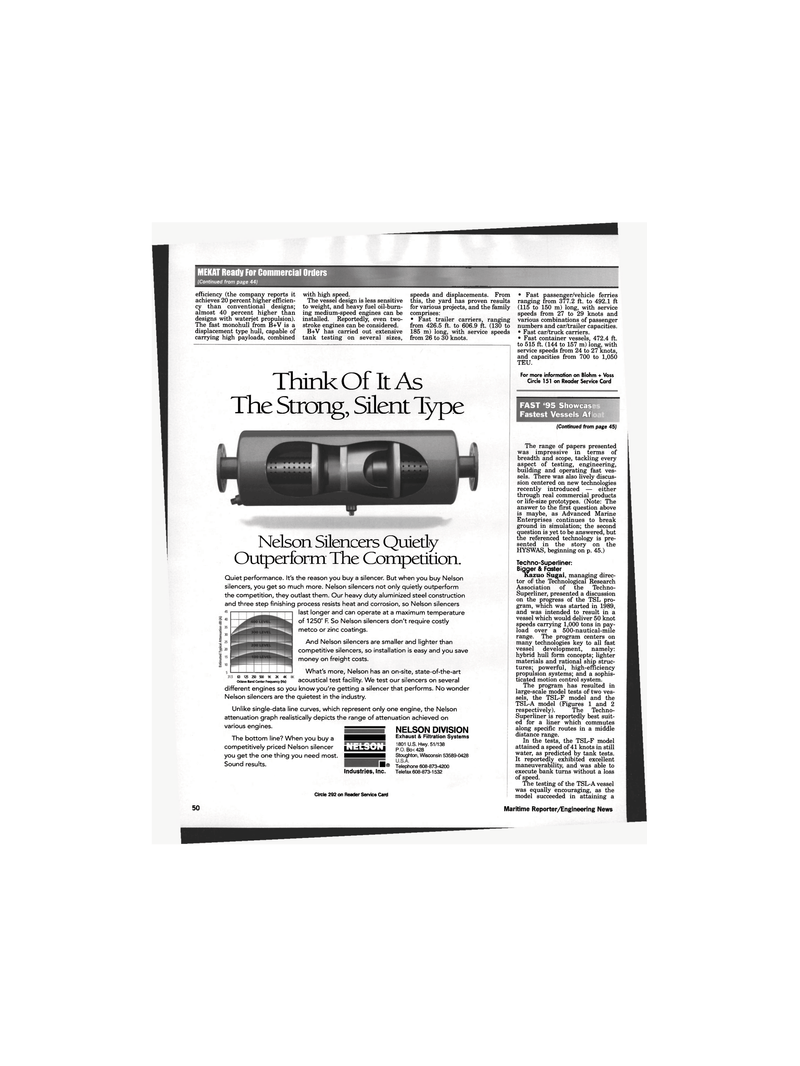
Page 48: of Maritime Reporter Magazine (November 1995)
Read this page in Pdf, Flash or Html5 edition of November 1995 Maritime Reporter Magazine
MEKAT Ready For Commercial Orders (Continued from page 44) efficiency (the company reports it achieves 20 percent higher efficien- cy than conventional designs; almost 40 percent higher than designs with waterjet propulsion).
The fast monohull from B+V is a displacement type hull, capable of carrying high payloads, combined with high speed.
The vessel design is less sensitive to weight, and heavy fuel oil-burn- ing medium-speed engines can be installed. Reportedly, even two- stroke engines can be considered.
B+V has carried out extensive tank testing on several sizes, speeds and displacements. From this, the yard has proven results for various projects, and the family comprises: • Fast trailer carriers, ranging from 426.5 ft. to 606.9 ft. (130 to 185 m) long, with service speeds from 26 to 30 knots.
Think Of It As
The Strong, Silent Type
Nelson Silencers Quietly
Outperform The Competition.
Quiet performance. It's the reason you buy a silencer. But when you buy Nelson silencers, you get so much more. Nelson silencers not only quietly outperform the competition, they outlast them. Our heavy duty aluminized steel construction and three step finishing process resists heat and corrosion, so Nelson silencers last longer and can operate at a maximum temperature of 1250° F. So Nelson silencers don't require costly metco or zinc coatings.
And Nelson silencers are smaller and lighter than competitive silencers, so installation is easy and you save money on freight costs.
What's more, Nelson has an on-site, state-of-the-art acoustical test facility. We test our silencers on several different engines so you know you're getting a silencer that performs. No wonder
Nelson silencers are the quietest in the industry.
Unlike single-data line curves, which represent only one engine, the Nelson attenuation graph realistically depicts the range of attenuation achieved on various engines. ——— NELSON DIVISION
The bottom line? When you buy a Exhaust & Filtration Systems competitively priced Nelson silencer p8"1^®^ 51/138 you get the one thing you need most. Stoughton, Wisconsin 53589-0428 • ® Telephone 608-873-4200
Industries, Inc. Telefax 608-873-1532
Circle 292 on Reader Service Card 63 125 250 500 IK 2K 4K
Octave Band Center Frequency (Hz)
Sound results. • Fast passenger/vehicle ferries ranging from 377.2 ft. to 492.1 ft (115 to 150 m) long, with service speeds from 27 to 29 knots and various combinations of passenger numbers and car/trailer capacities. • Fast car/truck carriers. • Fast container vessels, 472.4 ft. to 515 ft. (144 to 157 m) long, with service speeds from 24 to 27 knots, and capacities from 700 to 1,050
TEU.
For more information on Blohm + Voss
Circle 151 on Reader Service Card
FAST '95 Showcas
Fastest Vessels Af (Continued from page 45)
The range of papers presented was impressive in terms of breadth and scope, tackling every aspect of testing, engineering, building and operating fast ves- sels. There was also lively discus- sion centered on new technologies recently introduced — either through real commercial products or life-size prototypes. (Note: The answer to the first question above is maybe, as Advanced Marine
Enterprises continues to break ground in simulation; the second question is yet to be answered, but the referenced technology is pre- sented in the story on the
HYSWAS, beginning on p. 45.)
Techno-Superliner:
Bigger & Faster
Kazuo Sugai, managing direc- tor of the Technological Research
Association of the Techno-
Superliner, presented a discussion on the progress of the TSL pro- gram, which was started in 1989, and was intended to result in a vessel which would deliver 50 knot speeds carrying 1,000 tons in pay- load over a 500-nautical-mile range. The program centers on many technologies key to all fast vessel development, namely: hybrid hull form concepts; lighter materials and rational ship struc- tures; powerful, high-efficiency propulsion systems; and a sophis- ticated motion control system.
The program has resulted in large-scale model tests of two ves- sels, the TSL-F model and the
TSL-A model (Figures 1 and 2 respectively). The Techno-
Superliner is reportedly best suit- ed for a liner which commutes along specific routes in a middle distance range.
In the tests, the TSL-F model attained a speed of 41 knots in still water, as predicted by tank tests.
It reportedly exhibited excellent maneuverability, and was able to execute bank turns without a loss of speed.
The testing of the TSL-A vessel was equally encouraging, as the model succeeded in attaining a 50 Maritime Reporter/Engineering News

 47
47

 49
49
